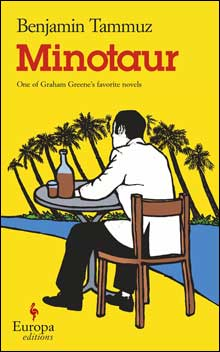 Graham Greene and John le Carré have long cornered the market on tales of gray, dour espionage mandarins who, with inevitably tragic results, feel their lives revitalized by a taste of romantic love. So it’s no wonder that Greene called Benjamin Tammuz’s novel Minotaur “the best of the year” when it was published in 1989. The Russian-born Tammuz immigrated to Palestine when he was five, working as a diplomat, sculptor, and literary editor of the newspaper Ha’aretz before dying the year Minotaur appeared.
Graham Greene and John le Carré have long cornered the market on tales of gray, dour espionage mandarins who, with inevitably tragic results, feel their lives revitalized by a taste of romantic love. So it’s no wonder that Greene called Benjamin Tammuz’s novel Minotaur “the best of the year” when it was published in 1989. The Russian-born Tammuz immigrated to Palestine when he was five, working as a diplomat, sculptor, and literary editor of the newspaper Ha’aretz before dying the year Minotaur appeared.
Minotaur is the story of an Israeli agent who on his 41st birthday sees an English girl of 17 and falls in love with her. His courtship — and that formal word describes the way he woos her — is entirely epistolary. He sends his Thea letters spilling out his longing, his conviction that she is the salvation he missed. When words fail him, he sends his favorite recordings of Mozart. Thea responds with letters of her own, trusting that they will find him (the name he instructs her to send them to is “Mr. Franz Kafka”), wondering what his long silences mean, journeying from her native England to teach in Spain.
If the doomed atmosphere that hovers over the romances in Greene and le Carré is present in Minotaur, so is a flavor that can only be described as more continental (Greene’s Englishmen abroad, or in England, never gave the impression of seeing very much around them), and prose more sensuous than fits into the schemes of those two writers. There are passages in Minotaur where the abandon of sensuousness comes close to dispelling the oppressiveness of melancholia. From one of the agent’s early letters:
I dreamed about you last night. I was standing alone on a balcony and you appeared in the doorway, looked at me, and smiled. Then you came toward me. You didn’t really walk but float through the air till you reached my side. You didn’t embrace me or reach out to me but lean slightly toward me and kiss me on the lips; I burst into tears, and you smiled and said, “I belong to you. Take me.” I said, “How can I take you?” And you said, “In the air. Take me in the air.”
This passage reveals the other influence on Tammuz in Minotaur: Lolita, with its essential chasteness. The sinister fumblings of Humbert that his “Lo” both resists and gives into is, for both Nabokov and his protagonist, the most transitory part of their relationship, something that brings Humbert and Lo wretchedness. At the end of the novel, Humbert is talking of “aurochs and angels,” convinced this is the only immortality he and his Lolita can share.
Tammuz operates in a less rarefied version of this realm. The ardor he writes of is the ardor of devotion and not physicality. (You could say the same about the American novel that is the truest descendant of Lolita, Marc Behm’s The Eye of the Beholder, which may owe just as much to Dashiell Hammett’s Red Harvest, though it just about quintuples the number of that novel’s corpses.) The book operates in sections told from the characters’ different points of view, allowing the agent, Thea, and the man who will sunder them to assume center stage. But the purely mental and spiritual connection between these two lovers operating sometimes thousands of miles apart is the guts of the book. At the end you have the sensation of having read something both exquisitely controlled and unutterably sad — as if the sadness had finally overwhelmed even Tammuz’s clockwork design.
ADVERTISEMENT
 |